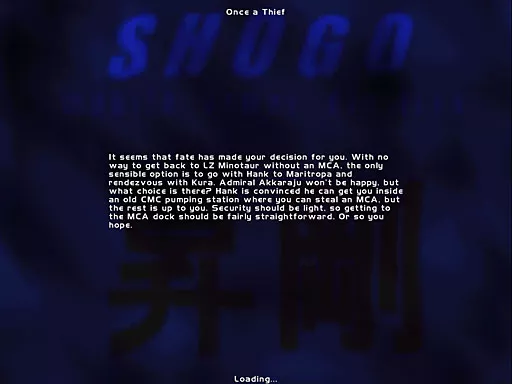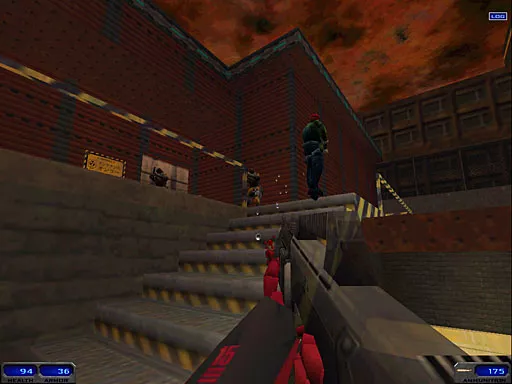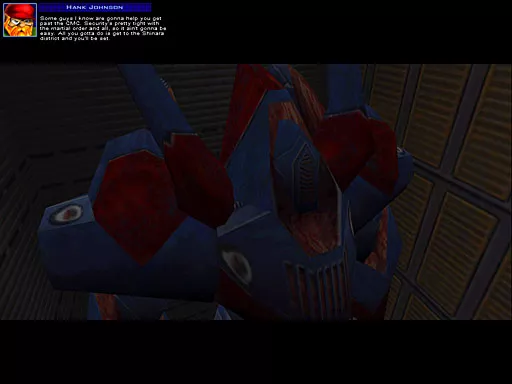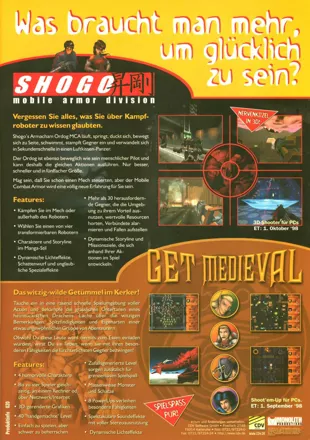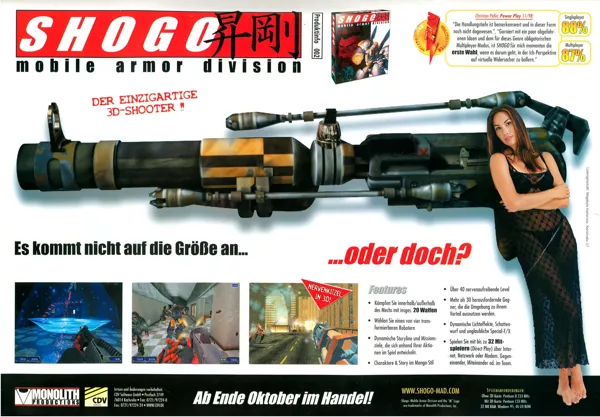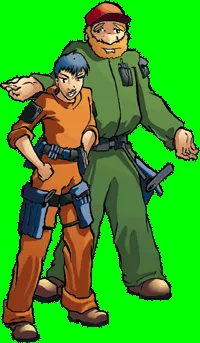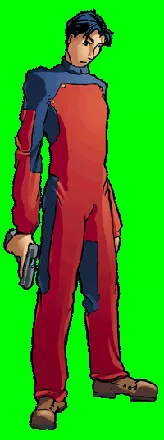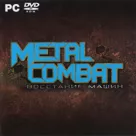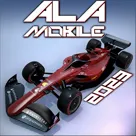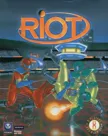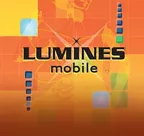Shogo: Mobile Armor Division
Description official descriptions
Sanjuro is a commander in the army of United Corporate Authority and a pilot of a Mobile Combat Armor (a giant mech) in the far future. The UCA is fighting the Fallen, a terrorist organization. This conflict has its victims: Sanjuro's brother, best friend and girlfriend all died while completing a mission years ago, and only recently he has been somewhat succeeding in putting the past behind him. Now Sanjuro is given a mission to find and kill Gabriel, a new leader of the Fallen. But during this assignment, ghosts of the past will come back to haunt him.
Shogo: Mobile Armor Division is a first-person shooter that incorporates ideas from anime and the MechWarrior series. On some levels, the player controls Sanjuro while he is on foot, infiltrating enemy buildings and fighting with handheld firearms. Sanjuro can find health power-ups, more powerful weapons and ammo. Both Sanjuro and the enemies will randomly score critical his, which not only cause more damage, but also replenish a small portion of health.
On other levels, the player pilots one of the four available MCAs, which differ a little in characteristics. This giant mech can walk, jump and crouch just like a human being, and controlling it is very similar to controlling Sanjuro. The player guides this colossus through city districts swarming with enemy soldiers and mechs. It is also possible to transform the mech into a vehicle, though it can not defend itself in that state.
The story progression is linear for the most part. However, at one point, the player is prompted to make a choice that will affect the rest of the plot and the ending.
Spellings
- Ярость. Восстание на Кронусе - Russian spelling
Groups +
Screenshots
Promos
Videos
See any errors or missing info for this game?
You can submit a correction, contribute trivia, add to a game group, add a related site or alternate title.
Credits (Windows version)
74 People · View all
| Game Designer and Lead Level Designer | |
| Lead Game Engineer | |
| Lead LithTech Engineer | |
| LithTech Sound System and Tools Engineer | |
| Lead Texture Artist and Designer | |
| Level and Game Designer | |
| Lead 3D Animator | |
| Game Engineer | |
| Producer | |
| Level Designer | |
| Mecha Designer and Texture Artist | |
| LithTech Engineer | |
| Texture Artist |
|
| Lead Audio Designer | |
| Weapon and Character Designs by | |
| Audio Composer | |
| Audio Technician | |
| Additional LithTech and Shogo Engineering by | |
| Additional 3D Animation | |
| [ full credits ] | |
Reviews
Critics
Average score: 82% (based on 36 ratings)
Players
Average score: 3.8 out of 5 (based on 72 ratings with 5 reviews)
More Shooter like than Mech Sim, Great game!
The Good
The game's most impressive feature is its anime style.From its Japanese rock music intro, to its humoristic ending anime is everywhere. All characters in the game are drawn in an anime fashion, the robots when they move have the foot stomp sound. When characters notice you there is that sun clang ever prevalent in anime. The Mech designs are top notch, enemies and good guys look great. The good guys get to choose 3 types of Mech, and if you don't like the one you have, you can change it during certain points in the game. The Mech weapons are the ones that really shine. The Mech weapons includes Pulse Cannons, Sniper Rifles, Lasers, and this Nuke weapon called the 'Red Riot'. Lastly, it is extremely fun to go around in the Mech stomping on infantry, and destroying billboards and automobiles. The human weapons also have cool reload and pull out animations and sounds. Oh ya, the game is also filled with sarcastic dialogue by the protagonist, and one character is for purely comedic purposes.
The Bad
There is nothing I really didn't like about the game. I think the story was to cliche. Of course it is the typical family vs. duty type storyline where the main character has a brother and a girlfriend lost in battle. Also, you know to soon of who the main bad guy is, and who is everyone else. The scripting deals mostly with go to one location and someone or something talks. There is no terrain deformation like in Half-life. Lastly, while I said the Mech weapons are impressive, the human weapons are pretty typical.
The Bottom Line
The game is basically an FPS. The Mech part is no Mechwarrior combat, it sticks more to FPS. The game is pretty easy for most shooter fans, and has the anime feel.
Windows · by Mister_T (15) · 2000
Has lots of cool things but Monolith just couldn't put it all together.
The Good
Plenty of good, pulse-pounding action comes packed in Shogo, an fps that gives you the chance to fight enemies both on foot or aboard a gigantic mecha and rain hell over cities and military complex... cool innit?
The game is a standard plot-driven fps game, even if it plays by missions. You have your share of scripted sequences as well as other plot-enhancing features like different plot threads (which can lead you to two very different game endings as well as different missions) and other gimmicks.
As I mentioned before, the action takes center stage in this game, so you can expect fast and furious fps fights courtesy of the Lithtech engine. The engine may not be the flashiest thing out there (especially in this early incarnation of it) but it does deliver fluid animation and fast graphics with lots of explosions and lightning effects. An interesting feat included in the engine is the real-time hit area detection which means that enemies react accordingly to your hits depending on where do you hit them just like in Blood 2. Though this may spell interesting strategic possibilities the fact is that it's just an aesthetic touch, and there's absolutely nothing wrong with that! You can juggle your opponents in the air with multiple hits, or get quick laughs as you hit them in the knees and watch them do the famed "machine gun cha-cha". That coupled with the amount of enemies and gang-bang type of firefights gets you a fantastically hyperkinetic experience that goes hand in hand with Shogo's outlandish animé world.
Of course, when you take the seat of one of the 3 mechas, the game takes a slightly different edge and you play in a much more over-the top enviroment where you can make gigantic jumps, wield absolutely devastating weapons that can level entire cities, and generally raise some major hell in the name of virtual entertainment. Yay! The mecha-segments are also the ones that feature some of the best level designs in the game, a great level has you jumping from skyscraper to skyscraper while shooting down enemy mechas as you try to get to the other side of the city, and an easy but dramatic fight takes place on the main building in an eery construction yard... very nice, quite a refreshment from the standard fps sequences of "fetch key, go kill gonzo, repeat".
The animé angle is pretty amusing when coupled to an fps game, and it's well implemented too since obviously the developers knew what makes the genre tick and capitalized on most of it's common points. The background storyline deals with some typical war among some military factions in the future, but as in most good animés this is just a backdrop for the personal struggles of the main characters, their sappy melodramas, their feelings of guilt, teen angst, etc. etc. I know I make it sound like crap, but it's a great capture of the "generic animé spirit" if that spirit is crap well, that's another issue...
The Bad
The game is just a mess. Save for the few points I mentioned up there the whole thing just seems hastily stitched together. It's not that bad really, but I get the feeling the guys at Monolith realized that an animé-based game fps would be a cool idea so they bothered to research all the art, licensed the world's crappiest J-pop song (as per standard animé requirements) and wrote a typically entertaining melodrama-in-war story that fitted the genre, but didn't actually put that much thinking in the general construction of the game. The levels themselves hardly ever make sense from a gameflow perspective, and they fall to some of the worst cliches ever in the genre (the last level if you choose to go against your superiors is a throwback to fps hell for instance). The mission design is often inconsistent and just boils down to "shoot the hell out of everything" and the AI is terribly predictable and stupid (especially that of the "bosses").
To further prove that the developers spent all the time thinking of cool things to jam in their game and not how the game used them you have a collection of genuinely good concepts that are blatantly wasted for no reason! ie: you have some stealthy weapons, but the game always forces you into head-on confrontations, so what is the use for them? When piloting mechas you can transform them into some weird-ass vehicles that only make you move slightly faster, but since you lose control of your weapons and there are no situations that call for you to "run to x place" or "escape x thing" what's the use?? Want more? By the 3rd/4th mission you'll already have the full, yes FULL, arsenal for your mecha!! (well, except for that Red Riot thingie that you get at the end)... what's the point of being able to choose from eight or so super kickass weapons if they all just fall on your ass from the get-go? This may sound stupid, but remember how gaining each weapon was a dramatic and super thrilling moment in games like Half-Life or Doom?? And each one was instantly cleverly introduced to you so that you could carefully experiment and find out their pros and cons? Well, Shogo just throws the whole arsenal at you! Have fun! You just start choosing the ones that seem more powerful and work your way downwards! Geez... and the worst part is that the mecha weapons are incredibly cool! And speaking of Mechas, why didn't they introduce at least some differences in gameplay or interface? Would it have killed them to provide a HUD or something to remind you that you are actually in an armored behemoth and not just playing the same fps game only in gigantor-mode and with different textures? Man, what a waste....
Oh, and lest I forget: This early versions of the LithTech engine had some major issues with some 3D cards. I hardly think they are a problem nowadays, but they were one to me in it's time, with dissapearing walls, textures, critters, etc... Don't say I didn't warn you!
The Bottom Line
Shogo has a lot of cool elements and creative juice, but it doesn't seem to pull it down into the reality of it's own game. The game just feels like a loose collection of ideas and concepts, whenever they do merge together you get a glimpse of Shogo's potential, specially with it's fierce and intense firefights and Mecha action. But for the most part it's just an averagely entertaining game that's hard to recommend in the face of all the other superior games out there.
And that song... THAT HELLISH SONNGGAAARARHRHH!!!!!!!
Windows · by Zovni (10504) · 2003
The Good
Shogo combined the giant robot antics of Mechwarrior with the infantry shooting of something like Quake. It was one of a pair of games from 1998 that used the original Lithtech 3D engine. Whereas the other game, Blood II, was tedium incarnate, Shogo was entertaining but frustratingly bitty. It is strange that there was never a sequel.
I enjoyed Shogo, and this despite the fact that I generally despise fans of Japanese animation. I do not so much despise the animation itself - which looks lovely - but the fans, who are loathsome. The Wikipedia entry for this game repels me, with its thousand-word summary of the game's plot, which is soap opera drivel of the "and then he did this and then he did that and this happened and they went there and did that" variety. A lot of things happen, but it means nothing. It is complicated like a plate of mashed potato; the crevices and crags are infinite in their variety but it is nonetheless just a blob of mashed spud. A work of art is more than a description of the composition and arrangement of its component parts.
The graphics were very attractive for 1998, particularly the cloudy skies, smoke trails, and glowing lights, although the objects and buildings were also very simple. The decision to use a mannered graphic style - based on Japanese kid's cartoons - worked well to hide the simplicity and low polygon count. Nonetheless the game had a clean, simple, futuristic design. The ability of your mech to leap tall buildings with a single bound was liberating.
The walking-about gameplay was, surprisingly, more realistic than that of Quake and its ilk. You could kill the infantry soldiers with one or two shots, and they could damage you badly too. It was almost Rainbow Six-esque, and it is only recently that this type of gameplay has become mainstream. For once there was an incentive for you to duck behind corners, although it always seemed a little half-baked - as if the designers had planned a more complicated game, but time pressures had forced them to cut corners. I can only review the finished product, not the process.
The Bad
That was the thing. The game seemed half-finished; as if the designers had wrapped it up, but had been pressed for time to polish it or add anything other than the bare bones. The levels were short and it didn't take long to finish the game. When you did, you were let down by a clearly unfinished final animation. There was a story; it didn't mean anything. I can name some of the people from Deus Ex, which I have not played in years, but the story and milieu of Shogo has fled my mind. Deus Ex had events, whereas Shogo was just a lot of incidents.
The levels alternated between giant robot combat and running around on the ground. But the two modes felt almost the same, and the gameplay was fundamentally identical, except from a higher perspective. You could turn your robot into an unarmed but fast ground car, although there was never any reason to do so. Your robot moved around and sidestepped just like a person. It did not have inertia and it did not feel like a hundred tonnes of metal, unlike the robots from Mechwarrior 2, which were hefty.
Some of the platform action was frustrating; I remember one level which involved jumping about in the clouds, and you could easily plummet to your death, which was plausible all right but no fun.
Although the game was inspired by Japanese animation, it didn't go all the way. The cityscapes were anonymous. The mechs were clunky, the characters were not exaggerated enough. Shogo's biggest failing was that it was bland.
That, and the fact it came out around the same time as Half-Life, which crushed it underfoot like I would crush a wounded bee with my leather boots. Half-Life was a carefully-crafted game made by creative, intelligent professionals in love with their work; a game written by and aimed at thinking, intelligent adults who had read books other than science fiction and fantasy; a polished game that belied the great thought with which it had been created. In contrast, Shogo always felt a little like a demo for the Lithtech engine. No matter how long the designers of Shogo had been given, it would not have been long enough. They were not up to it.
The Bottom Line
Rather like its stablemate Blood II, Shogo came and went without leaving a trace; the magazines ignored it and it went to budget quite quickly. A month or so later people were getting exciting about Half-Life, and to a lesser extent SiN. As I have already said, I enjoyed Shogo. It was entertaining, and came out at the very end of a short fallow people (I was not to know that Half-Life was a month or so away). But it was very transient.
When I finished it, I did not ever play it again, because there was no reason to do so. It nowadays seems very lost and dated and old. The Wikipedia entry states that there is a thriving fan community; but there is also a thriving community of P J Proby fans, and fans of the cult 1979 television series The Sandbaggers.
Windows · by Ashley Pomeroy (225) · 2006
Discussion
| Subject | By | Date |
|---|---|---|
| Review of Shogo: Mobile Armored Division | Eric Brewster | Mar 2, 2012 |
Trivia
If you keep scrolling past the credits you'll find some interesting messages. Some are just plain dumb (Shogo rulz, monolith rulz, etc...) but some, like the ones that tell of all the different names the game had (heavy metal, Metal Tek, Riot, etc.) are quite funny to read.
Analytics
Upgrade to MobyPro to view research rankings!
Related Sites +
-
Planet Shogo
fan-site with everything from game info to cheats, editing and mods (archived - 2005)
Identifiers +
Contribute
Are you familiar with this game? Help document and preserve this entry in video game history! If your contribution is approved, you will earn points and be credited as a contributor.
Contributors to this Entry
Game added by Derrick 'Knight' Steele.
Linux added by chirinea. Amiga added by Kabushi. Macintosh added by Martin Smith.
Additional contributors: Zovni, Apogee IV, tarmo888, Ivan Napreenko, Stratege.
Game added March 26, 2000. Last modified February 13, 2024.


